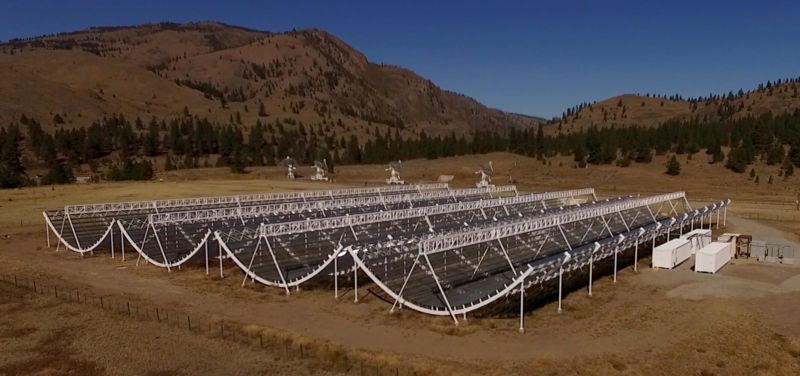
Fast Radio Bursts were discovered about a decade ago and have remained enigmatic since. Over the course of a few milliseconds, something—we have no idea what—releases a tremendous amount of energy at radio frequencies. With a single exception that launches repeated fast radio bursts, the sources are never heard from again.
When faced with an enigma like this, the standard scientific mantra applies: we need more data. So, in less than a decade, radio telescopes have been designed and built to identify more of these events. The latest entry, CHIME (for Canadian Hydrogen Intensity Mapping Experiment), has only just been built, but its builders started having it do science while still under construction. And CHIME quickly paid off by identifying the closest and lowest-frequency fast radio bursts yet found, along with only the second example of a repeating source.
A CHIME in progress
Just how unfinished was the new telescope? "New racks of compute nodes were being installed and the number of nodes operating, and hence beams on sky, varied from day to day," its scientists say. "Additionally, the number of compute nodes operating in the correlator, and hence the frequency coverage, also varied daily." Things were such that the data for a fast radio burst was lost, leaving scientists with only details from its metadata, like when and roughly where it occurred.
Despite the chaos, discoveries poured in—13 fast radio bursts were identified. Since CHIME is sensitive to lower frequencies of radiation than past telescopes, it discovered that fast radio bursts appear at lower frequencies than we had previously known. While that seems like a mundane discovery, knowing the frequency range that these things appear at could ultimately tell us something about the physical processes that produce them.
It's thought that the wavelengths produced by these events start out relatively well defined but get smeared across a longer range by interactions with the interstellar and intergalactic media during their transit to Earth. CHIME identified a fast radio burst with the lowest dispersion yet discovered, suggesting its source is the closest to Earth.
Make mine a sextuple
But perhaps the most significant discovery so far is FRB 180814.J0422+73. Unlike every other source discovered by CHIME so far, this object produced repeated bursts—six were identified in data taken during the instrument's commissioning. Previously, out of dozens that have been identified, only one other had produced multiple bursts, despite a growing number of surveys looking for these objects. It was beginning to look like the lone example, FRB 121102, might be a freak object, but this suggests that it may simply be rare. The new one was identified in part because it was near enough to the Earth's North Pole to show up in the CHIME field of view twice a day.
It's still not clear whether the two repeaters represent a distinct class of objects from those that produce a single burst. But like the earlier example, the new repeater shows that not all bursts end up being the same, despite what's presumably a single object producing them. Different bursts may be centered on different frequencies, while individual bursts may see their most prominent frequency drift over the course of milliseconds. In addition, the intensity of the burst over time can differ; some rise to a single sharp peak, while others have a more complicated structure.
The authors make a comparison between some of these properties and those of emissions produced by solar radio bursts, which are the product of shock-accelerated plasmas. It may be that fast radio bursts are produced by similar shocks occurring at a dramatically larger scale.
The CHIME team checked the location of the burst but didn't see anything especially obvious in that area of the sky. The source is estimated to be about 1.6 billion light years away, so seeing any details of what's going on is not going to be easy in any case.
While this preliminary data doesn't provide a clear indication of what fast radio bursts are, CHIME provides reason for optimism that the "we need more data" mantra is likely to be met. CHIME is now fully commissioned, and it will be taking data full time and with the instrument's full field of view.
Nature, 2019. DOI: 10.1038/s41586-018-0867-7, 10.1038/s41586-018-0864-x (About DOIs).
https://arstechnica.com/science/2019/01/new-canadian-telescope-spots-a-second-repeating-fast-radio-burst/Bagikan Berita Ini
















0 Response to "New Canadian telescope spots a second repeating Fast Radio Burst - Ars Technica"
Post a Comment